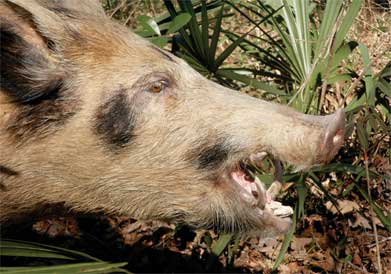|
|
Hog Wild In Florida! Feral Pigs A Problemdownloadable pdfFlorida's population boom now includes some 500,000 wild hogs whose piggish habits are causing problems for farmers, residents and health officials as well as native flora and fauna. “Nothing personal, but the only state with more wild hogs than Florida is Texas,” said Bill Giuliano, an assistant professor of wildlife ecology at the University of Florida’s Institute of Food and Agricultural Sciences. Wild or feral hogs can now be found in every Florida county and in at least 35 states — including 1 to 2 million hogs in the Southeast. Nationwide, their population totals about 3 million.
“Because they are prolific breeders, there is no way to completely eradicate them,” Giuliano said. “Even with intensive hunting pressure, you’re not going to get rid of them.” He said the problem can be traced to 1539 when Hernando DeSoto brought hogs into southwest Florida, and some of them found freedom in the New World. Nearly 500 years later, there are some 3 million descendants of these “pioneer pigs” across the nation. In Florida, some of the highest densities of feral hogs can be found north and west of Lake Okeechobee where large forested tracts, dense vegetation, abundant water and limited public access provide an ideal environment for the pigs. Hog numbers tend to be lower in areas with intensive agriculture or urban development. “Although they are a popular target for hunters, wild hogs are coming into conflict with people and wildlife,” Giuliano said. “Farmers are not happy when feral hogs root up their fields, and health officials say the animals carry diseases that could affect wildlife, livestock and people.” Giuliano, who conducts research on the animals with George Tanner, a professor in the UF wildlife ecology and conservation department, said hogs can also host many diseases and parasites, including hog cholera, psuedorabies, brucellosis, tuberculosis, salmonellosis, anthrax, ticks, fleas, lice and various flukes and worms. “Wild hogs, which usually weigh 100 to 200 pounds, are dangerous,” Giuliano said. “Although they prefer to run and escape danger, they can be aggressive when they’re injured or cornered. They can move with great speed and can cause serious injury with their tusks.” Acorns are their favorite food, but they will eat almost anything, including dead animals, and it seems like they’re always looking for opportunities, he said. When natural foods are scarce or inaccessible, hogs will forage on almost any agricultural crop and livestock feed. They will also feed on tree seeds and seedlings, causing significant damage in forests, groves and plantations. In Florida and the Southeast, this may be a problem in regenerating long-leaf pine forests. In addition to the effects of consuming, knocking down and trampling large amounts of native vegetation and crops, the rooting behavior of wild hogs causes significant damage, Giuliano said. Rooting — digging for foods below the surface of the ground — destabilizes the soil surface, uprooting or weakening native vegetation, damaging lawns and causing erosion. Their wallowing behavior destroys small ponds and stream banks, which may affect water quality. They also prey upon ground-nesting wildlife, including sea turtles. “Wild hogs compete for food with other game animals such as deer, turkeys and squirrels, and they may consume the nests and young of many reptiles, ground-nesting birds and mammals,” he said. “With their fine sense of smell, wild hogs can find and consume young domestic livestock, including poultry, lambs and goats. Millions of dollars are spent each year to prevent damage from hogs.” Tanner said it may be possible to limit further population expansion by hunting, various trapping methods and exclusion. Bill Giuliano, giulianob@wec.ufl.edu Chuck Woods
|

